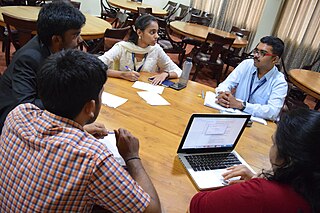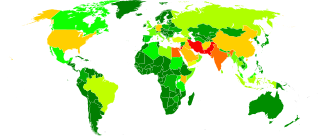Marketing research is the systematic gathering, recording, and analysis of qualitative and quantitative data about issues relating to marketing products and services. The goal is to identify and assess how changing elements of the marketing mix impacts customer behavior.

A focus group is a group interview involving a small number of demographically predefined participants. Their reactions to specific researcher/evaluator-posed questions are studied. Focus groups are used in market research to better understand people's reactions to products or services or participants' perceptions of shared experiences. The discussions can be guided or open. In market research, focus groups can explore a group's response to a new product or service. As a program evaluation tool, they can elicit lessons learned and recommendations for performance improvement. The idea is for the researcher to understand participants' reactions. If group members are representative of a larger population, those reactions may be expected to reflect the views of that larger population. Thus, focus groups constitute a research or evaluation method that researchers organize to collect qualitative data through interactive and directed discussions.
Text mining, text data mining (TDM) or text analytics is the process of deriving high-quality information from text. It involves "the discovery by computer of new, previously unknown information, by automatically extracting information from different written resources." Written resources may include websites, books, emails, reviews, and articles. High-quality information is typically obtained by devising patterns and trends by means such as statistical pattern learning. According to Hotho et al. (2005), there are three perspectives of text mining: information extraction, data mining, and knowledge discovery in databases (KDD). Text mining usually involves the process of structuring the input text, deriving patterns within the structured data, and finally evaluation and interpretation of the output. 'High quality' in text mining usually refers to some combination of relevance, novelty, and interest. Typical text mining tasks include text categorization, text clustering, concept/entity extraction, production of granular taxonomies, sentiment analysis, document summarization, and entity relation modeling.

Qualitative research is a type of research that aims to gather and analyse non-numerical (descriptive) data in order to gain an understanding of individuals' social reality, including understanding their attitudes, beliefs, and motivation. This type of research typically involves in-depth interviews, focus groups, or field observations in order to collect data that is rich in detail and context. Qualitative research is often used to explore complex phenomena or to gain insight into people's experiences and perspectives on a particular topic. It is particularly useful when researchers want to understand the meaning that people attach to their experiences or when they want to uncover the underlying reasons for people's behavior. Qualitative methods include ethnography, grounded theory, discourse analysis, and interpretative phenomenological analysis. Qualitative research methods have been used in sociology, anthropology, political science, psychology, communication studies, social work, folklore, educational research, information science and software engineering research.
Information extraction (IE) is the task of automatically extracting structured information from unstructured and/or semi-structured machine-readable documents and other electronically represented sources. Typically, this involves processing human language texts by means of natural language processing (NLP). Recent activities in multimedia document processing like automatic annotation and content extraction out of images/audio/video/documents could be seen as information extraction.
Open source intelligence (OSINT) is the collection and analysis of data gathered from open sources to produce actionable intelligence. OSINT is primarily used in national security, law enforcement, and business intelligence functions and is of value to analysts who use non-sensitive intelligence in answering classified, unclassified, or proprietary intelligence requirements across the previous intelligence disciplines.

Content analysis is the study of documents and communication artifacts, which might be texts of various formats, pictures, audio or video. Social scientists use content analysis to examine patterns in communication in a replicable and systematic manner. One of the key advantages of using content analysis to analyse social phenomena is their non-invasive nature, in contrast to simulating social experiences or collecting survey answers.

In systems engineering and software engineering, requirements analysis focuses on the tasks that determine the needs or conditions to meet the new or altered product or project, taking account of the possibly conflicting requirements of the various stakeholders, analyzing, documenting, validating, and managing software or system requirements.

A business analyst (BA) is a person who processes, interprets and documents business processes, products, services and software through analysis of data.The role of a business analyst is to ensure business efficiency increases through their knowledge of both IT and business function.
Job analysis is a family of procedures to identify the content of a job in terms of the activities it involves in addition to the attributes or requirements necessary to perform those activities. Job analysis provides information to organizations that helps them determine which employees are best fit for specific jobs.
Business analysis is a professional discipline focused on identifying business needs and determining solutions to business problems. Solutions may include a software-systems development component, process improvements, or organizational changes, and may involve extensive analysis, strategic planning and policy development. A person dedicated to carrying out these tasks within an organization is called a business analyst or BA.

Data analysis is the process of inspecting, cleansing, transforming, and modeling data with the goal of discovering useful information, informing conclusions, and supporting decision-making. Data analysis has multiple facets and approaches, encompassing diverse techniques under a variety of names, and is used in different business, science, and social science domains. In today's business world, data analysis plays a role in making decisions more scientific and helping businesses operate more effectively.
In computing, data transformation is the process of converting data from one format or structure into another format or structure. It is a fundamental aspect of most data integration and data management tasks such as data wrangling, data warehousing, data integration and application integration.
A market analysis studies the attractiveness and the dynamics of a special market within a special industry. It is part of the industry analysis and thus in turn of the global environmental analysis. Through all of these analyses the strengths, weaknesses, opportunities and threats (SWOT) of a company can be identified. Finally, with the help of a SWOT analysis, adequate business strategies of a company will be defined. The market analysis is also known as a documented investigation of a market that is used to inform a firm's planning activities, particularly around decisions of inventory, purchase, work force expansion/contraction, facility expansion, purchases of capital equipment, promotional activities, and many other aspects of a company.
The professional practice of behavior analysis is a domain of behavior analysis, the others being radical behaviorism, experimental analysis of behavior and applied behavior analysis. The practice of behavior analysis is the delivery of interventions to consumers that are guided by the principles of radical behaviorism and the research of both experimental and applied behavior analysis. Professional practice seeks to change specific behavior through the implementation of these principles. In many states, practicing behavior analysts hold a license, certificate, or registration. In other states, there are no laws governing their practice and, as such, the practice may be prohibited as falling under the practice definition of other mental health professionals. This is rapidly changing as behavior analysts are becoming more and more common.
Netnography is a "form of qualitative research that seeks to understand the cultural experiences that encompass and are reflected within the traces, practices, networks and systems of social media". It is a specific set of research practices related to data collection, analysis, research ethics, and representation, rooted in participant observation that can be conceptualized into three key stages: investigation, interaction, and immersion. In netnography, a significant amount of the data originates in and manifests through the digital traces of naturally occurring public conversations recorded by contemporary communications networks. Netnography uses these conversations as data. It is an interpretive research method that adapts the traditional, in-person participant observation techniques of anthropology to the study of interactions and experiences manifesting through digital communications.
QSR International is a qualitative research software developer based in Burlington, Massachusetts, with offices in Australia, Germany, New Zealand, and the United Kingdom. QSR International is the developer of qualitative data analysis (QDA) software products, NVivo, NVivo Server, Interpris and XSight. These are designed to help qualitative researchers organize and analyze non-numerical or unstructured data.

XKeyscore is a secret computer system used by the United States National Security Agency (NSA) for searching and analyzing global Internet data, which it collects in real time. The NSA has shared XKeyscore with other intelligence agencies, including the Australian Signals Directorate, Canada's Communications Security Establishment, New Zealand's Government Communications Security Bureau, Britain's Government Communications Headquarters, Japan's Defense Intelligence Headquarters, and Germany's Bundesnachrichtendienst.

Social media analytics or social media monitoring is the process of gathering and analyzing data from social networks such as Facebook, Instagram, LinkedIn, or Twitter. A part of social media analytics is called social media monitoring or social listening. It is commonly used by marketers to track online conversations about products and companies. One author defined it as "the art and science of extracting valuable hidden insights from vast amounts of semi-structured and unstructured social media data to enable informed and insightful decision-making."
Convenience sampling is a type of non-probability sampling that involves the sample being drawn from that part of the population that is close to hand.







